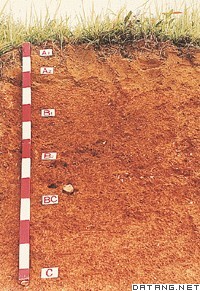1) Red soil structure


红壤结构
2) Soil structure


土壤结构
1.
Effects of tillage measures on soil structure and organic carbon of surface soil in semi-arid area of the western Loess Plateau;
陇中旱地不同保护性耕作方式表层土壤结构和有机碳含量比较分析
2.
Impacts of soil structure on shear-resistantance of soil under different land uses in Jinyun Mountain of Chongqing City;
重庆缙云山不同土地利用类型土壤结构对土壤抗剪性能的影响
3.
Theory and application of multi-scale and multi-resolution fragmentation method for soil structure evaluation;
多尺度多分辨率破碎方法评价土壤结构的原理及其应用
3) structural soil


结构土壤
4) concretionary laterite


结核砖红壤
5) lateritic crust


砖红壤结壳
6) soil structure


土壤结构性
1.
The research on the surface soil structure,soil anti-erosion and soil anti-scour in the limestone region of karst area in the middle of Guizhou prov- ince shows that arbor forest improve the soil structure and contain important function,the overlay degree of vegetation under the forest has the great influence on the soil structure.
贵州喀斯特地区土壤侵蚀十分严重,已引起广泛关注,通过对黔中喀斯特石灰岩地区表层土壤结构性。
补充资料:红壤
| 红壤 red earth 发育于热带和亚热带雨林、季雨林或常绿阔叶林植被下的土壤。主要特征是缺乏碱金属和碱土金属而富含铁、铝氧化物,呈酸性红色。主要分布于非洲、亚洲、大洋洲及南北美洲的低纬度地区。大致以南北纬30°为限。在中国,北起长江沿岸,南抵南海诸岛,东自台湾省,西至云贵高原及横断山脉为主要分布区域。红壤的形成是在高温多雨、植被茂密的生物、气候条件下,土壤中富铝化和生物富集相互作用的结果。根据成土条件的变化和富铝化作用的强度,中国境内红壤可分为砖红壤、砖红壤性红壤、红壤、黄壤4个亚类。前2类多见于热带和南亚热带,土体中碱金属及碱土金属含量均低,pH4.5~5.0,适宜种植热带和亚热带作物及水稻。第3类多见于亚热带低山丘陵地带,土壤pH5.0左右,富铝化程度较前2类弱,适宜种植亚热带经济作物和水稻、玉米等。为更好地利用红壤,须对其淋溶作用强、矿质养分少、酸性大、易产生铝锰毒害、保肥性能差和质地粘重或砂粒过多等不良性状进行改良。具体措施是:增施氮、磷、钾等矿质肥料,氮肥宜用粒状或球状深施,磷肥宜与有机肥混合制成颗粒肥施用;施用石灰降低土壤酸性;合理耕作;选种适当的作物、林木,种植绿肥是改良红壤的关键措施;旱地改水田,减少水土流失并有利于有机质积累,提高土壤生产力;保护植被,防治侵蚀,凡坡度大于25°的陡坡应以种树种草为主,小于25°的坡地根据陡缓状况修建宽窄不等的等高梯地或梯田种植。
|
说明:补充资料仅用于学习参考,请勿用于其它任何用途。
参考词条
